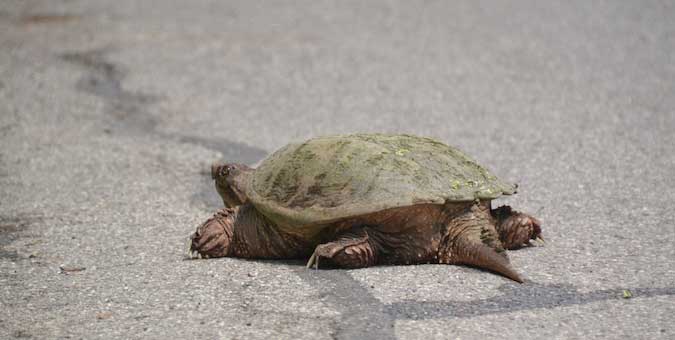DEC urges motorists to be careful of turtles crossing roads
Turtles will be on the move in May and June to lay eggs

Photo by Tom Rivers: This snapping turtle is shown last June after it managed to cross Route 31 in Fancher. Many snapping turtles were on the move crossing roads to find spots to lay their eggs.
Press Release, NYS Department of Environmental Conservation
New York State Department of Environmental Conservation (DEC) Commissioner Basil Seggos today reminded New Yorkers that turtles are on the move in the months of May and June, and asked drivers to “give turtles a brake.”
In New York, thousands of turtles are killed each year when struck by vehicles while migrating to nesting areas. Increasing public awareness of turtles’ nesting behavior can help save this important species.
“A turtle’s shell provides good protection from natural predators, but it cannot protect a turtle from being hit by a vehicle while crossing a road,” Seggos said. “Vehicle strikes are a major cause of turtle mortality and New York’s native turtles are more active this time of year as they seek sandy areas or loose soil to lay their eggs, sometimes even near the side of a road.”
If a motorist sees a turtle on the road, drivers are encouraged to slow down to avoid hitting it with their vehicle. If the vehicle can safely stop, motorists should consider moving the turtle to the shoulder on the side of the road in the direction it was facing.
Motorists are advised not to pick turtles up by their tails to avoid injuring the turtle. Most turtles, other than snapping turtles, can be picked up by the sides of their shell. Snapping turtles have necks that can reach a long distance and have a strong bite, so if motorists try to help a snapping turtle, they should pick it up by the rear of the shell near the tail using both hands or slide a car mat under the turtle to drag it safely across the road.
DEC reminds people to never take turtles home. All native turtles are protected by law and cannot be kept without a DEC permit.
All 11 species of land turtles native to New York are in decline. Turtles are long-lived species and it takes many years for a turtle to reach maturity. Even losing one mature female can have a negative impact on a local population.





























































